Files in this item
The biodiversity, ecosystem functioning and value of restored salt marshes in the Eden Estuary, Scotland
Item metadata
| dc.contributor.advisor | Paterson, D. M. (David M.) | |
| dc.contributor.advisor | Hanley, Nick | |
| dc.contributor.advisor | Gollety, Claire | |
| dc.contributor.author | Wade, Katherine Scarlett | |
| dc.coverage.spatial | x, 236, [41] p. | en_US |
| dc.date.accessioned | 2019-04-18T13:37:22Z | |
| dc.date.available | 2019-04-18T13:37:22Z | |
| dc.date.issued | 2018 | |
| dc.identifier.uri | https://hdl.handle.net/10023/17541 | |
| dc.description.abstract | The ecosystem service (ES) framework is increasingly being incorporated into management decisions, providing a basis by which ES can be quantified to understand the impact of decisions to society and the environment. Our ability to effectively implement this framework is dependent on our knowledge of the links between natural capital, ecosystem functions and ES. A need to ensure that the theoretical model is grounded in scientific evidence exists. This thesis employed ecological and economic methods to apply the ES framework in assessing the ability of restored salt marsh to provide coastal defences, and the perceived value of this by the public. Using sites planted as part of ongoing restoration in the Eden Estuary, Scotland, ecosystem functions important to the provision of coastal flood defence were assessed for equivalence to natural salt marsh sites. Plant structure was found to develop along a trajectory expected to attain comparable ecosystem function to a natural marsh. Comparable plant height was attained 10 years after planting, however marginal significant differences were still present in plant density. Due to high spatial and temporal variation no trajectory for sediment stability could be inferred. Overall, this work suggests that equivalent coastal defence provision is highly likely to be attained within the planted sites. Comparable benthic macrofaunal species richness and abundance were observed 2-3 and 4–9 years after planting, respectively; community assemblage continued to differ after 11 years. A choice experiment indicated a clear dislike for the use of engineered walls and a preference for nature-based defences within the Eden Estuary. A combination of a low wall and fronting salt marsh was preferred with the highest willingness to pay. Combining the findings from ecological and economic research enables insights that can assist in the planning of coastal flood defence providing valuable information to managers and policy makers. | en_US |
| dc.language.iso | en | en_US |
| dc.publisher | University of St Andrews | |
| dc.subject.lcc | QH141.W2 | |
| dc.subject.lcsh | Biodiversity--Scotland | en |
| dc.subject.lcsh | Conservation of natural resources--Scotland | en |
| dc.subject.lcsh | Environmental policy--Scotland | en |
| dc.subject.lcsh | Environmental protection--Scotland | en |
| dc.subject.lcsh | Eden River Estuary (Scotland) | en |
| dc.title | The biodiversity, ecosystem functioning and value of restored salt marshes in the Eden Estuary, Scotland | en_US |
| dc.type | Thesis | en_US |
| dc.type.qualificationlevel | Doctoral | en_US |
| dc.type.qualificationname | PhD Doctor of Philosophy | en_US |
| dc.publisher.institution | The University of St Andrews | en_US |
This item appears in the following Collection(s)
Items in the St Andrews Research Repository are protected by copyright, with all rights reserved, unless otherwise indicated.

